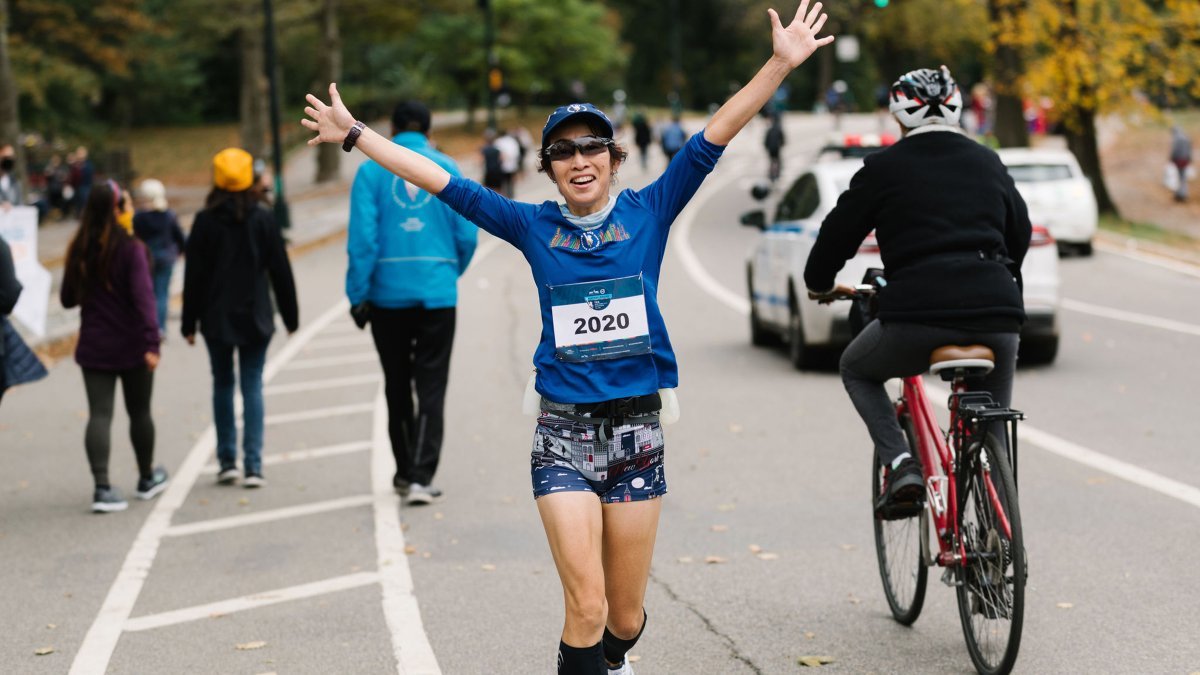No products in the cart.
Outdoor Adventure
The New York City Marathon Lives On
In a parallel, non pandemic-stricken universe, last Sunday, November 1, was the day when 50,000 runners poured over the Verrazano-Narrows Bridge to kick off the NYC Marathon. Instead, what would have been the 50th anniversary edition of the race was canceled back in June, to the surprise of absolutely no one. Those of us who live in New York and are silly enough to get emotional about mass-participation sporting events had plenty of advance notice that there would be no roaring, 26.2-mile carnival in the streets this year. But of course, you still miss the trappings of marathon weekend, which, given the scale of the event, would probably be more accurately described as “marathon month and a half”: The hyper-affirmative subway ads (“It will move you!”). The conspicuous marathon tourists, patrolling midtown in tracksuits, ready to gorge themselves on diner pasta. The bleachers on the West Drive of Central Park, set up by the finish line two weeks before the race. If you’re a runner, it’s impossible to see them and not feel a jolt of adrenaline.
There was none of it in 2020. It should go without saying that, on Sunday morning in New York, racing conditions were more or less optimal: Overcast. 50 degrees. Minimal wind. No one has ever accused the marathon gods of not having a sense of humor.
If nothing else, the ideal weather was likely appreciated by locals who took part in the virtual edition of the NYC Marathon and who decided to do their “race” on the official day. (Anyone who participated in the virtual event, which had a $50 entry fee for New York Road Runners members and $60 for everyone else, needed to run 26.2 miles at some point between October 17 and November 1 to earn a finisher’s medal.) This was a popular choice. Many New York-based runners ran the official course on Sunday for their virtual race, with the exception of the initial two-mile stretch across the Verrazzano, which is closed to pedestrians.
There was even a cameo appearance from the professional ranks on what would have been “Marathon Saturday.” Des Linden, who was the fastest American woman at last year’s NYCM, ran 31 miles in Central Park to complete a month-long personal challenge she’d dubbed #RunDestober, which required her to match the calendar date in daily mileage. After capping off a 196-mile final week, Linden celebrated by drinking Champagne out of her shoes. These are trying times and we’re all doing the best we can.

As for others in the elite field, such as it was, Emily Sisson and Stephanie Bruce also ran virtual NYCMs, logging 2:38:32 and 2:35:28 respectively, according to an NYRR representative. (Sisson completed her NYCM in San Diego, while Bruce did hers at elevation, near Flagstaff.) Meanwhile, wheelchair athlete Daniel Romanchuk set an unofficial world record of 1:13:57—blazing down a straight section of farm roads in central Illinois. (According to an article in Runner’s World, his mother drove behind him to make sure he wasn’t hit by an oblivious motorist.) At this time last year, Romanchuk was feted by hundreds of spectators as he came up the final incline by Tavern on the Green to claim his second consecutive NYCM win. Things were a little lonelier in 2020.
“Normally my sister, who’s an ER nurse in New York City, is there to give me an ‘annoying’ big sister hug and kiss at the finish line,” Romanchuk posted on Instagram after his virtual NYCM. “I never knew how much I’d miss that . . . I can’t wait to get that hug and kiss in person again next year.” One can only hope.
In his 1949 essay Here is New York, E.B. White wrote that, due to its size and endless hyperlocal goings-on, New York “succeeds in insulating the individual against all enormous and violent and wonderful events that are taking place at every minute.” Hence, “every event is, in a sense, optional, and the inhabitant is in the happy position of being able to choose his spectacle and so conserve his soul.” Seventy years later, this notion of self-imposed, splendid isolation feels like a relic from a lost age—even, or perhaps especially, in New York, whose violent and wonderful events feel more ubiquitous than ever. When the city was the global epicenter of the pandemic back in April, everyone heard the sirens in the street. A year from now, if we’re very lucky, a different kind of inescapable spectacle will be back: the sight of thousands of runners progressing through the five boroughs, en route to Central Park. If you didn’t know any better, you’d think the course was designed to disrupt the lives of as many New Yorkers as possible.
We wouldn’t want it any other way.
Support Outside Online
Our mission to inspire readers to get outside has never been more critical. In recent years, Outside Online has reported on groundbreaking research linking time in nature to improved mental and physical health, and we’ve kept you informed about the unprecedented threats to America’s public lands. Our rigorous coverage helps spark important debates about wellness and travel and adventure, and it provides readers an accessible gateway to new outdoor passions. Time outside is essential—and we can help you make the most of it. Making a financial contribution to Outside Online only takes a few minutes and will ensure we can continue supplying the trailblazing, informative journalism that readers like you depend on. We hope you’ll support us. Thank you.
Lead Photo: NYRR

